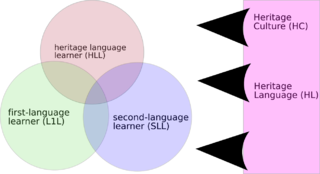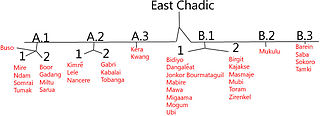Related Research Articles

An endangered language or moribund language is a language that is at risk of disappearing as its speakers die out or shift to speaking other languages. Language loss occurs when the language has no more native speakers and becomes a "dead language". If no one can speak the language at all, it becomes an "extinct language". A dead language may still be studied through recordings or writings, but it is still dead or extinct unless there are fluent speakers. Although languages have always become extinct throughout human history, they are currently dying at an accelerated rate because of globalization, imperialism, neocolonialism and linguicide.
Lists of endangered languages are mainly based on the definitions used by UNESCO. In order to be listed, a language must be classified as "endangered" in a cited academic source. Researchers have concluded that in less than one hundred years, almost half of the languages known today will be lost forever. The lists are organized by region.
Language revitalization, also referred to as language revival or reversing language shift, is an attempt to halt or reverse the decline of a language or to revive an extinct one. Those involved can include parties such as linguists, cultural or community groups, or governments. Some argue for a distinction between language revival and language revitalization. It has been pointed out that there has only been one successful instance of a complete language revival, that of the Hebrew language, creating a new generation of native speakers without any pre-existing native speakers as a model.

The three dozen East Chadic languages of the Chadic family are spoken in Chad and Cameroon.
Negidal is a language of the Tungusic family spoken in the Russian Far East, mostly in Khabarovskij Kraj, along the lower reaches of the Amur River. Negidal belongs to the Northern branch of Tungusic, together with Evenki and Even. It is particularly close to Evenki, to the extent that it is occasionally referred to as a dialect of Evenki.
The Gong language is an endangered Tibeto-Burman language of Western Thailand, spoken in isolated pockets in Uthai Thani and Suphanburi provinces.

Rutul is a language spoken by the Rutuls, an ethnic group living in Dagestan (Russia) and some parts of Azerbaijan. It is spoken by 30,000 people in Dagestan and 17,000 in Azerbaijan. The word Rutul derives from the name of a Dagestani village where speakers of this language make up the majority.
Language preservation is the effort to prevent languages from becoming unknown. A language is at risk of being lost when it no longer is taught to younger generations, while fluent speakers of the language die.
El Molo is a possibly extinct language belonging to the Cushitic branch of the Afro-Asiatic language family. It was spoken by the El Molo people on the southeastern shore of Lake Turkana, in northern Kenya. Alternate names to El Molo are Dehes, Elmolo, Fura-Pawa, and Ldes. It was thought to be extinct in the middle part of the 20th century, but a few speakers were found in the later 20th century. However, it may now be truly extinct, as the eight speakers found in a survey published in 1994 were over 50. Most of the El Molo population have shifted to the neighboring Samburu language. El Molo also has no known dialects.
Baldemu, or Mbazlam, is a nearly extinct Afro-Asiatic language spoken in northern Cameroon. Baldamu is spoken in Bogo commune, Diamaré department, Far North Region by only 5 speakers as of 2012. Speakers have been shifting to Fulfulde.
Barein is a Chadic language spoken in south central Chad.
The Baale language, Baleesi or Baalesi, is a Surmic language spoken in Ethiopia and South Sudan by the Baale or Zilmamo people of Ethiopia, and by the Kachepo of South Sudan. It is a member of the Surmic cluster; the self-name of the language and the community is Suri, which is the same as that of the Suri language, evoking an ethnonym that embraces the Tirma, Chai, and Baale communities, although linguistically the languages of these communities are different. There are currently 9,000 native speakers of Baleesi, 5,000 in South Sudan and 4,100 in Ethiopia; almost all of these are monolingual.
Watiwa is a Rai Coast language of Papua New Guinea.
Mamaindê, also known as Northern Nambikwara, is a Nambikwaran language spoken in the Mato Grosso state of Brazil, in the very north of the indigenous reserve, Terra Indígena Vale do Guaporé, between the Pardo and Cabixi Rivers. In the southern part of the reserve, speakers of Sabanê and Southern Nambikwara are found.
Koro is a possibly Sino-Tibetan language spoken by approximately 800–1,500 people in the East Kameng district at the western end of Arunachal Pradesh, India. Few speakers are under 20 years old. The people live among the Aka (Hruso), but their language is only distantly related, with distinct words for numerals, body parts, and other basic vocabulary. The majority of Koro speakers live in bilingual households in which one or more members speak Ako or another indigenous language rather than Koro. Although it has resemblances to Tani farther to the east, it appears to be at least a separate branch of Sino-Tibetan. Researchers hypothesize it may have originated from a group of people enslaved and brought to the area.
Kayeli is an extinct Austronesian language once used by the Kayeli people of the Indonesian island Buru. Two dialects were recognized, namely Leliali (Liliali) and Lumaete.
Koda, also known as Kora, Kaora, Korali, Korati, Kore, Mudi, or Mudikora, is an endangered Munda language of India and Bangladesh spoken by the Kora. The Kora mainly live in West Bengal, in the districts of Paschim Medinipur and Bankura, with a few in neighbouring Odisha and Jharkhand. In 2005, there were 1,300 speakers in the Rajshahi Division of Bangladesh, though many said that Bengali was their best language. Koda is closely related to the Kol language.
Thakali is a Sino-Tibetan language of Nepal spoken by the Thakali people, mainly in the Myagdi and Mustang Districts. Its dialects have limited mutual intelligibility.
Iyive, also referred to as Uive, Yiive, Ndir, Asumbos, is a severely endangered Bantoid language spoken in Nigeria and Cameroon. The ethnic group defined by use of this language is the Ndir.
Within the linguistic study of endangered languages, sociolinguists distinguish between different speaker types based on the type of competence they have acquired of the endangered language. Often when a community is gradually shifting away from an endangered language to a majority language, not all speakers acquire full linguistic competence; instead, speakers have varying degrees and types of competence depending on their exposure to the minority language in their upbringing. The relevance of speaker types in cases of language shift was first noted by Nancy Dorian, who coined the term semi-speaker to refer to those speakers of Sutherland Gaelic who were predominantly English-speaking and whose Gaelic competence was limited and showed considerable influence from English. Later studies added additional speaker types such as rememberers, and passive speakers. In the context of language revitalization, new speakers who have learned the endangered language as a second language are sometimes distinguished.
References
- 1 2 Mabire at Ethnologue (18th ed., 2015) (subscription required)
- ↑ "UNESCO Atlas of the World's Languages in danger".
- ↑ http://www.sil.org/silewp/2012/silewp2112–004FINAL.pdf [ dead link ]
- ↑ "Endangered Languages Project - Mabire - Mabire: A Dying Language of Chad".
- ↑ Eric Johnson & Cameron Hamm. 2002. "Mabire: A Dying Language of Chad," SIL Electronic Working Papers 2002-002. online